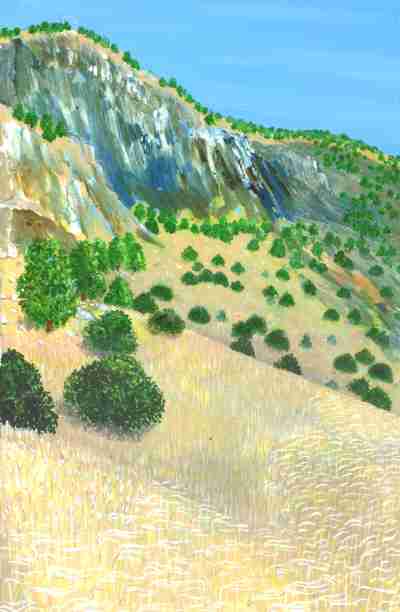Portfolio > The Quest for Food: Excerpts
|
Primate
Diets All illustrations by the author Ivan Crowe |
CerealsFood resources of terebinth woodland-steppe
Illustration based on slides and information supplied by Gordon Hillman The transition from oak park-woodland to terebinth woodland-steppe was once one of the richest ecosystems of south-west Asia and provided some of the key food resources for the people living there during the Epipalaeolithic. On the high slopes acorns could be gathered from the oaks and wild pears while lower down was the terebinth-almond woodland steppe that gradually gave way to the treeless steppe. Within this border zone grew wild wheats and further down wild barley and then feather grass, all of which could provide edible grain or seeds that could be stored throughout the year. But as the climate became drier the wild cereals disappeared from many areas. It was in response to these changes, in the region where the wild cereals originally grew, that the first steps towards farming were taken, when people began to plant these wild cereals in new locations. (Hillman et al 2000 ) The effect of harvesting The actual method by which cereals were harvested might have been a factor influencing their domestication. Gordon Hillman and Stuart Davies (1990) have shown that there are basically five main methods that can be used to harvest cereals. The first of these is burning, when the stands are fired and the parched seeds are afterwards collected from off the ground. The second is to beat the seed into basket and the third is hand stripping the ears of seed. None of these methods result in the collection of a more than average amount of mutant forms. However, a fourth method, namely the uprooting of the entire plant does, providing the seed is at least partially ripe, as does the fifth method, harvesting with a sickle. Hillman's and Davies' experiments, conducted on wild stands in Turkey, have demonstrated that one of these last two methods is the most probable way in which the mutant forms were unconsciously advantaged and came to dominate the crop.* A significant number of the seeds which fall to the ground upon ripening, are eaten either by birds or insects and other predators of seeds. The result is that only about 20% to 50% of these self-sown seeds survive to germinate. If a large number of these seeds was regularly lost to predators every year, this would favour an increase in the relative abundance of mutant forms, simple because the seed retained by the farmer, containing a large number of mutants, was not subject to the same predation. Under these favourable circumstances, the number of mutants would increase, even if the retained seed was sown in the same area from which it was gathered. But if the number of wild forms surviving in some years was higher than usual, then these could have swamped the numbers of mutants, once again reducing the frequency of mutant incidence among the crops being cultivated. For these reasons, another factor was probably critical in influencing the pace of domestication, that of the percentage of the seed collected that is subsequently sown. Gordon Hillman and Stuart Davies (1990) have estimated that if 25% of the seed collected when using a sickle is retained each year for sowing a progressively larger number of these mutant forms will appear in the crop each year, until eventually an entirely domestic strain of cereal becomes established. Once this happened these cereals were entirely dependent on human intervention for their propagation. At this point the crop is fully domesticated. |
|
* Technical Note The ears of wild cereals will normally 'disarticulate' immediately upon maturity. In the wild state, it is this fragility that ensures the scattering of the seed that will produce new plants the following season. But this does not always happen. Among any wild stand of wild wheat for example, one can usually find a small number of mutant plants in which the ears do not disarticulate so easily. Because they were not easily scattered, in the wild, these mutants would have rarely germinated -- and so never had the chance to supersede the parent species. When being collected merely for food the situation remained much the same -- but if some of the seed collected was later sown an entirely new set of circumstances came into play. |





